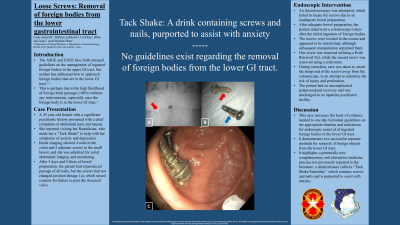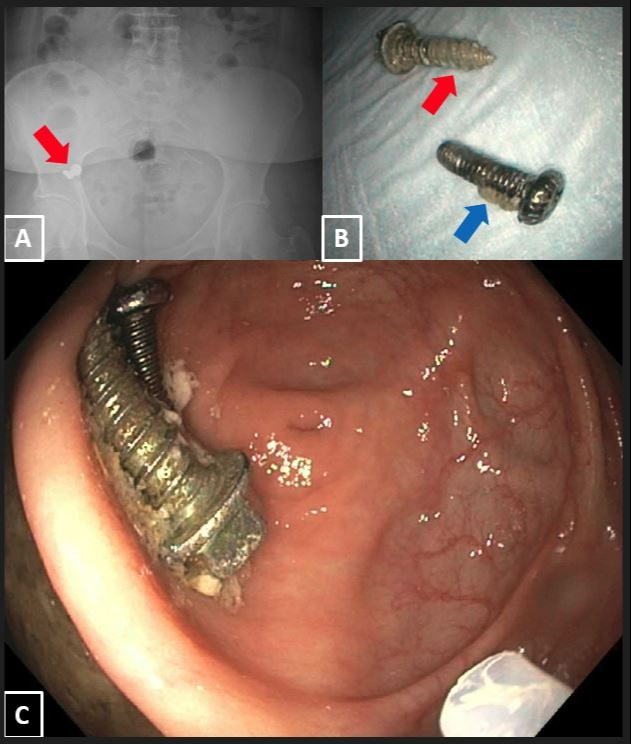Back


Poster Session A - Sunday Afternoon
Category: General Endoscopy
A0285 - Loose Screws: Removal of Foreign Bodies From the Lower Gastrointestinal Tract
Sunday, October 23, 2022
5:00 PM – 7:00 PM ET
Location: Crown Ballroom

Has Audio
- CA
Cody Ashcroft, MD
Brooke Army Medical Center
Fort Sam Houston, TX
Presenting Author(s)
Cody Ashcroft, MD1, William M. LaShomb, MD2, Carl L. Kay, MD3, Billy-Joe Liane, MD4, Christian Horn, MD5
1Brooke Army Medical Center, Fort Sam Houston, TX; 2San Antonio Uniformed Services Health Education Consortium, San Antonio, TX; 3Brooke Army Medical Center, JBSA Fort Sam Houston, TX; 4Brooke Army Medical Center, San Antonio, TX; 5San Antonio Military Medical Center, Fort Sam Houston, TX
Introduction: The American Society for Gastrointestinal Endoscopy and European Society of Gastrointestinal Endoscopy have both released guidelines on the management of ingested foreign bodies in the upper GI tract, but neither has addressed how to approach foreign bodies that are in the lower gastrointestinal (GI) tract. This is perhaps due to the high likelihood of foreign body passage ( >80%) without any interventions, especially once the foreign body is in the lower GI
Case Description/Methods: A 45 year-old female with a significant psychiatric history presented with a chief complaint of abdominal pain and nausea. She reports visiting her Rastafarian, who made her a “Tack Shake” to help with her symptoms of anxiety and depression. Physical exam was overall unremarkable, and she was persistently hemodynamically stable and afebrile. Laboratory findings were also unremarkable and demonstrated no evidence of other toxic ingestions or infection. Initial imaging showed 4 nails in the colon and 2 adjacent screws in the small bowel, and she was admitted for serial abdominal imaging and monitoring. After 5 days and 8 liters of bowel preparation, the patient had experienced passage of all nails, but the screws had not changed position (Image 1a). As this presentation raised concern for failure to pass the ileocecal valve, an ileocolonoscopy was performed 6 days after the initial ingestion of foreign bodies. The screws were located in the cecum and appeared to be intertwined, although subsequent manipulation separated them (Image 1c). One screw was removed utilizing a Roth Retrieval Net, while the second screw was removed using a cold snare (Image 1b). During retraction, care was taken to orient the sharp end of the screws away from the colonoscope, in an attempt to minimize the risk of injury and perforation. The patient had an uncomplicated postprocedural recovery and was discharged to an inpatient psychiatric facility.
Discussion: This case increases the body of evidence needed to formulate guidelines on the appropriate timeline and indications for endoscopic removal of ingested foreign bodies in the lower GI tract. It also demonstrates two successful separate methods for removal of foreign objects from the lower GI tract. Additionally, it highlights a potentially new complementary and alternative medicine practice not previously reported in the literature: a drink/mixture called a “Tack Shake,” which contains screws and nails and is purported to assist with anxiety.

Disclosures:
Cody Ashcroft, MD1, William M. LaShomb, MD2, Carl L. Kay, MD3, Billy-Joe Liane, MD4, Christian Horn, MD5. A0285 - Loose Screws: Removal of Foreign Bodies From the Lower Gastrointestinal Tract, ACG 2022 Annual Scientific Meeting Abstracts. Charlotte, NC: American College of Gastroenterology.
1Brooke Army Medical Center, Fort Sam Houston, TX; 2San Antonio Uniformed Services Health Education Consortium, San Antonio, TX; 3Brooke Army Medical Center, JBSA Fort Sam Houston, TX; 4Brooke Army Medical Center, San Antonio, TX; 5San Antonio Military Medical Center, Fort Sam Houston, TX
Introduction: The American Society for Gastrointestinal Endoscopy and European Society of Gastrointestinal Endoscopy have both released guidelines on the management of ingested foreign bodies in the upper GI tract, but neither has addressed how to approach foreign bodies that are in the lower gastrointestinal (GI) tract. This is perhaps due to the high likelihood of foreign body passage ( >80%) without any interventions, especially once the foreign body is in the lower GI
Case Description/Methods: A 45 year-old female with a significant psychiatric history presented with a chief complaint of abdominal pain and nausea. She reports visiting her Rastafarian, who made her a “Tack Shake” to help with her symptoms of anxiety and depression. Physical exam was overall unremarkable, and she was persistently hemodynamically stable and afebrile. Laboratory findings were also unremarkable and demonstrated no evidence of other toxic ingestions or infection. Initial imaging showed 4 nails in the colon and 2 adjacent screws in the small bowel, and she was admitted for serial abdominal imaging and monitoring. After 5 days and 8 liters of bowel preparation, the patient had experienced passage of all nails, but the screws had not changed position (Image 1a). As this presentation raised concern for failure to pass the ileocecal valve, an ileocolonoscopy was performed 6 days after the initial ingestion of foreign bodies. The screws were located in the cecum and appeared to be intertwined, although subsequent manipulation separated them (Image 1c). One screw was removed utilizing a Roth Retrieval Net, while the second screw was removed using a cold snare (Image 1b). During retraction, care was taken to orient the sharp end of the screws away from the colonoscope, in an attempt to minimize the risk of injury and perforation. The patient had an uncomplicated postprocedural recovery and was discharged to an inpatient psychiatric facility.
Discussion: This case increases the body of evidence needed to formulate guidelines on the appropriate timeline and indications for endoscopic removal of ingested foreign bodies in the lower GI tract. It also demonstrates two successful separate methods for removal of foreign objects from the lower GI tract. Additionally, it highlights a potentially new complementary and alternative medicine practice not previously reported in the literature: a drink/mixture called a “Tack Shake,” which contains screws and nails and is purported to assist with anxiety.

Figure: 1A: Plain radiograph depicting persistent foreign objects
1B: Removed screws with blunt (blue arrow) and sharp (red arrow) tips
1C: Positioning of the screws in the cecum
1B: Removed screws with blunt (blue arrow) and sharp (red arrow) tips
1C: Positioning of the screws in the cecum
Disclosures:
Cody Ashcroft indicated no relevant financial relationships.
William LaShomb indicated no relevant financial relationships.
Carl Kay indicated no relevant financial relationships.
Billy-Joe Liane indicated no relevant financial relationships.
Christian Horn indicated no relevant financial relationships.
Cody Ashcroft, MD1, William M. LaShomb, MD2, Carl L. Kay, MD3, Billy-Joe Liane, MD4, Christian Horn, MD5. A0285 - Loose Screws: Removal of Foreign Bodies From the Lower Gastrointestinal Tract, ACG 2022 Annual Scientific Meeting Abstracts. Charlotte, NC: American College of Gastroenterology.
